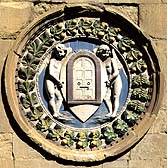Italiano
Grazie !

"Ariento" Consortium

List of Members

Tradition of Florentine Silverware

E-mail
|
 |
[ Page 2 of 4 ]  A long
apprenticeship, that lasted for six years, which
guaranteed the preparation of the disciples. Whilst,
workshops had to be opened in clear view, so that
everyone was able to see, and control with ease, what was
happening within. By the beginning of the 1400s, it had
even been established that the silversmiths' workshops
were concentrated in the most ancient and central part of
the city. Some streets, along with their names, like the
"Vicolo (1) dell'Oro (2)", the "Via (3)
dell'Ariento (4)" and the "Via del Gomitolo
dell'Oro", (1- vicolo-lane, 2- oro-gold, 3-
via-street, 4- Ariento, argento-silver) still record the
ancient settlements. Antonio di Salvi and Paolo di
Giovanni Sogliani were silversmiths, members of the Arts,
or else they worked forming themselves in their youth, in
a silversmith's, beyond excellence. Their superb works
are still conserved in the museum of "Il
Bargello" and of the "Cathedral works".
Also among the other pieces in these museums, are the
works of very famous fifteenth century artists, that
contributed to making Florence, the "capital of
humanism", and moreover, the cultural capital of the
West in such an extraordinary period. The first among
these artists to be remembered, is Filippo Brunelleschi,
and then, only to cite a few others, Lorenzo Ghiberti,
Antonio del Pollaiolo, Paolo Uccello and Michelozzo, whom
were also architects, sculptors or painters, according to
that unitary conception of the arts that, typical of the
Gothic Era, was exalted in Florence in the Renaissance
period. To the silver and gold pieces being produced, was
assigned the duty of representing the prestige of the
city. This is still demonstrated by the most exquisite
and important works including the golden doors of the
Baptistery, and the superb treasures that it holds. For
example, the silver altar, which took almost a whole
century to complete, started in 1366, with the
furnishings consisting of chandeliers, Pollaiolo's cross,
and innumerable precious relics. A long
apprenticeship, that lasted for six years, which
guaranteed the preparation of the disciples. Whilst,
workshops had to be opened in clear view, so that
everyone was able to see, and control with ease, what was
happening within. By the beginning of the 1400s, it had
even been established that the silversmiths' workshops
were concentrated in the most ancient and central part of
the city. Some streets, along with their names, like the
"Vicolo (1) dell'Oro (2)", the "Via (3)
dell'Ariento (4)" and the "Via del Gomitolo
dell'Oro", (1- vicolo-lane, 2- oro-gold, 3-
via-street, 4- Ariento, argento-silver) still record the
ancient settlements. Antonio di Salvi and Paolo di
Giovanni Sogliani were silversmiths, members of the Arts,
or else they worked forming themselves in their youth, in
a silversmith's, beyond excellence. Their superb works
are still conserved in the museum of "Il
Bargello" and of the "Cathedral works".
Also among the other pieces in these museums, are the
works of very famous fifteenth century artists, that
contributed to making Florence, the "capital of
humanism", and moreover, the cultural capital of the
West in such an extraordinary period. The first among
these artists to be remembered, is Filippo Brunelleschi,
and then, only to cite a few others, Lorenzo Ghiberti,
Antonio del Pollaiolo, Paolo Uccello and Michelozzo, whom
were also architects, sculptors or painters, according to
that unitary conception of the arts that, typical of the
Gothic Era, was exalted in Florence in the Renaissance
period. To the silver and gold pieces being produced, was
assigned the duty of representing the prestige of the
city. This is still demonstrated by the most exquisite
and important works including the golden doors of the
Baptistery, and the superb treasures that it holds. For
example, the silver altar, which took almost a whole
century to complete, started in 1366, with the
furnishings consisting of chandeliers, Pollaiolo's cross,
and innumerable precious relics.
|






 A long
apprenticeship, that lasted for six years, which
guaranteed the preparation of the disciples. Whilst,
workshops had to be opened in clear view, so that
everyone was able to see, and control with ease, what was
happening within. By the beginning of the 1400s, it had
even been established that the silversmiths' workshops
were concentrated in the most ancient and central part of
the city. Some streets, along with their names, like the
"Vicolo (1) dell'Oro (2)", the "Via (3)
dell'Ariento (4)" and the "Via del Gomitolo
dell'Oro", (1- vicolo-lane, 2- oro-gold, 3-
A long
apprenticeship, that lasted for six years, which
guaranteed the preparation of the disciples. Whilst,
workshops had to be opened in clear view, so that
everyone was able to see, and control with ease, what was
happening within. By the beginning of the 1400s, it had
even been established that the silversmiths' workshops
were concentrated in the most ancient and central part of
the city. Some streets, along with their names, like the
"Vicolo (1) dell'Oro (2)", the "Via (3)
dell'Ariento (4)" and the "Via del Gomitolo
dell'Oro", (1- vicolo-lane, 2- oro-gold, 3-








